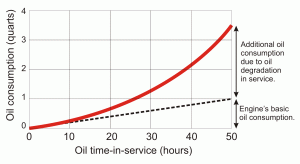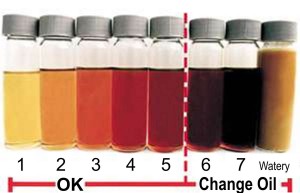Checking the Dipstick

It turns out that there’s a lot more to checking the engine’s oil dipstick properly than just making sure that the oil level is above the minimum-for-flight level listed in the POH. If we really pay attention, we can learn a lot about the condition of our oil and of our engine.
How much oil is needed?
The engines on my Cessna 310 have 12-quart sumps—13 quarts if you include the quart in the spin-on oil filter. When I first acquired the airplane, my mechanic would fill the sump to its maximum capacity at each oil change. It didn’t take me long to discover that the engines didn’t like that, and promptly tossed several quarts out the engine breathers.
My POH states that the “minimum for flight” oil level is 9 quarts. So I asked my mechanic to service the sump to 10 quarts (instead of 12), and I’d add a quart of make-up oil when the level got down to 9 quarts. That worked better, but I was still seeing a fair amount of oil on the underside of the engine nacelles and the outer gear doors.
After I became a mechanic myself and learned about such things, I checked the Type Certificate Data Sheet (TCDS) for my Continental TSIO-520-BB engines, and found that an oil level of 6 quarts was sufficient to make good oil pressure in all flight attitudes from 23° nose-up to 17° nose-down. Armed with this information, I decided to experiment with lower oil levels.
What I discovered was that oil consumption (and the oily mess on the airframe) was drastically reduced if I maintained the oil level at around 8 quarts on the dipstick. Since then, I’ve avoided filling the sump to more than 9 quarts, and I normally do not add make-up oil until the dipstick reads about 7½ quarts. (This still gives me a 1½-quart “cushion” above what the engine needs to operate reliably in all flight attitudes.)
You might wonder why Continenta put a 12-quart sump on an engine that requires only 6 quarts. The answer is that FAA certification requirements demand that the engine be designed to hold twice as much oil as it actually needs:
FAR §33.39 Lubrication system.
(a) The lubrication system of the engine must be designed and constructed so that it will function properly in all flight attitudes and atmospheric conditions in which the airplane is expected to operate. In wet sump engines, this requirement must be met when only one-half of the maximum lubricant supply is in the engine.
The TCDS for my TSIO-520-BB engines states that maximum acceptable oil consumption is about one quart per hour. If my engines actually used that much oil, then I’d need to fill the sumps nearly to their maximum capacity to ensure that I had enough oil to make a 5-hour flight without risking oil starvation. But since I know from long experience that my engines use more like 0.1 quart per hour, there’s no reason for me to carry anywhere near that much oil.
Every aircraft engine installation has an optimum oil level at which oil consumption is minimized and the engine is happiest. I would encourage you to experiment to determine what oil level works best for your airplane. Your engine will operate properly at 50% of its maximum oil capacity—guaranteed. As long as you keep the oil level a quart or two above the 50% point, your engine will be happy.
The best time to get an accurate dipstick reading is just prior to the first flight of the day. If you check the oil level shortly after the engine has been run for awhile, the dipstick reading will be noticeably lower because a significant quantity of oil remains adhered to various engine components. Another reading taken 24 hours later will often show an oil level that is ½ to 1 quart higher.
Oil consumption?
Having assured yourself that there’s enough oil in the engine, your next task is to make note of how much oil your engine is using. Keeping track of oil consumption—particularly any significant increase in oil consumption rate—is an important tool for monitoring engine condition.
The most common method of measuring oil consumption is to record how many quarts of make-up oil are added between oil changes, and to divide the total by the number of hours in the oil-change interval. (For example, if the oil is changed after 50 hours and 6 quarts of make-up oil were added during that time, the average oil consumption rate is 50/6 or 8.3 hours per quart.)

However, this approach obscures the fact that oil consumption is not linear over the oil change interval. If you keep track of when you add each quart of make-up oil, you’ll find that less oil is consumed at first, and progressively more oil is consumed as the oil’s time-in-service increases.
The reason for this accelerating oil consumption is that the viscosity of the oil decreases as the oil deteriorates. Mineral oils lose viscosity due to a phenomenon called “polymer shearing” in which the long organic molecules are actually broken apart by mechanical action of the engine’s moving parts. Multigrade oils also lose viscosity because their viscosity-index improvers oxidize when exposed to high temperatures.
The increased rate of oil consumption provides tangible evidence that your engine oil is getting “long in the tooth” and ought to be changed soon.
What does your oil look like?
Whenever you check the dipstick, it’s also important to make note of the oil’s appearance—particularly its color and clarity. The oil’s appearance offers valuable clues to its condition and that of your engine.

Fresh engine oil has a light amber color and is so transparent that it’s sometimes hard to read the dipstick level. As the oil remains in service, it gradually darkens in color and becomes progressively more opaque.
The darkening of engine oil is caused by contamination and oxidation. Contaminants include carbon (soot), lead salts and sulfur from combustion byproducts that get past the compression rings and into the crankcase (“blow-by”), as well as any dust or dirt that gets past the induction air filter. Oxidation of the oil occurs when it is exposed to high localized temperatures at it circulates through the engine, and results in the formation of coke. Various oil additives are also vulnerable to oxidation, particularly the viscosity-index improvers used in multiweight oils.
Dispersant additives are blended in the oil to help keep these so-called “insolubles” in suspension in order to keep the engine clean and minimize sludge deposits. As the quantity of insolubles in suspension increases, the oil darkens and becomes opaque.
It is important to note how quickly this darkening occurs. If your oil remains relatively light-colored and translucent after 25 hours in service, you can be reasonably confident that your cylinders and rings are in fine condition and that your oil can prudently remain in service for 40 or 50 hours. On the other hand, if your oil gets dark and opaque after 10 or 15 hours, you’d be wise to change your oil more often—perhaps at 25 hours—and you may want to investigate the possibility that one or more cylinders are excessively worn.
Such rapid discoloration is often a good indicator that the oil is distressed. In one study, 90% of oil that appeared abnormally dark on the dipstick was subsequently found by laboratory analysis to be non-compliant with required specifications. Oil that is dark and opaque from blow-by past the rings is very likely to be rich in acids and other corrosive compounds that can attack your cam and lifters, and that’s probably the #1 cause of engines failing to make TBO. Any time your oil appears dark or opaque, you would be wise to drain it and replace it with fresh oil and a new oil filter, regardless of the oil’s time-in-service.



